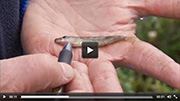|
Introduction | Overview | Teacher Resources |
Introduction
Welcome to the Stickleback Evolution Lab. You will be introduced to the science and techniques used to analyze the forms and structures of organisms – in particular, the pelvic morphology of the threespine stickleback fish (Gasterosteus aculeatus).
This virtual laboratory teaches skills of data collection and analysis to study evolutionary processes.
The lab includes several short videos explaining research methods and relating the evolutionary history of the stickleback fish. Throughout the lab, bolded, blue words are defined in the glossary under the Reference tab; you can hover the mouse cursor over these words to see their definitions. (This option is not available for mobile devices.)
The threespine stickleback fish is a model organism for studying evolution. The ancestral forms of stickleback fish are small ocean dwellers that sport heavy armor in the form of bony plates and spines
projecting from the back and pelvis. This armor protects ocean sticklebacks from predatory attacks. Some species of stickleback fish are anadromous and, like salmon, travel from the ocean via rivers to spawn in freshwater lakes. At the end of the last ice age, some stickleback populations became trapped in lakes that were cut off from the ocean in the wake of retreating ice fields. In the past 20,000 to 10,000 years, these stranded populations evolved dramatically over generations as they adapted to living permanently in a freshwater environment. For example, in many freshwater populations, the ocean sticklebacks' fully formed pelvic girdle, with long spines, became greatly reduced.

Click on the icon above to watch a video about
pelvic reduction in freshwater stickleback populations.
Because there are hundreds of postglacial lakes in the Northern Hemisphere, researchers can compare a trait like pelvic reduction in different stickleback populations and make predictions about which environmental conditions influence the trait. The rich fossil record of the threespine stickleback allows researchers to precisely calculate the rate of evolution of pelvic reduction, which is easily measured in fossil fish.

Evolutionary biologist Dr. Michael A. Bell explains
why the stickleback is a model organism for studying evolution.
In the past decade, researchers have learned a lot about the genes responsible for a number of traits in sticklebacks. At least one gene responsible for the development of the stickleback pelvis and spines has homology to a gene involved in hind-limb formation in mice and other vertebrates—suggesting that pelvic formation occurs through a genetic mechanism shared through common ancestry. Hind-limb reduction has occurred in several vertebrate lineages, including manatees, snakes, and whales. Thus, studies of pelvic reduction in the threespine stickleback can provide insights into general evolutionary principles.

Watch a video of Dr. David Kingsley
discussing hind-limb reduction.
Click on the lab window on the left to get started!